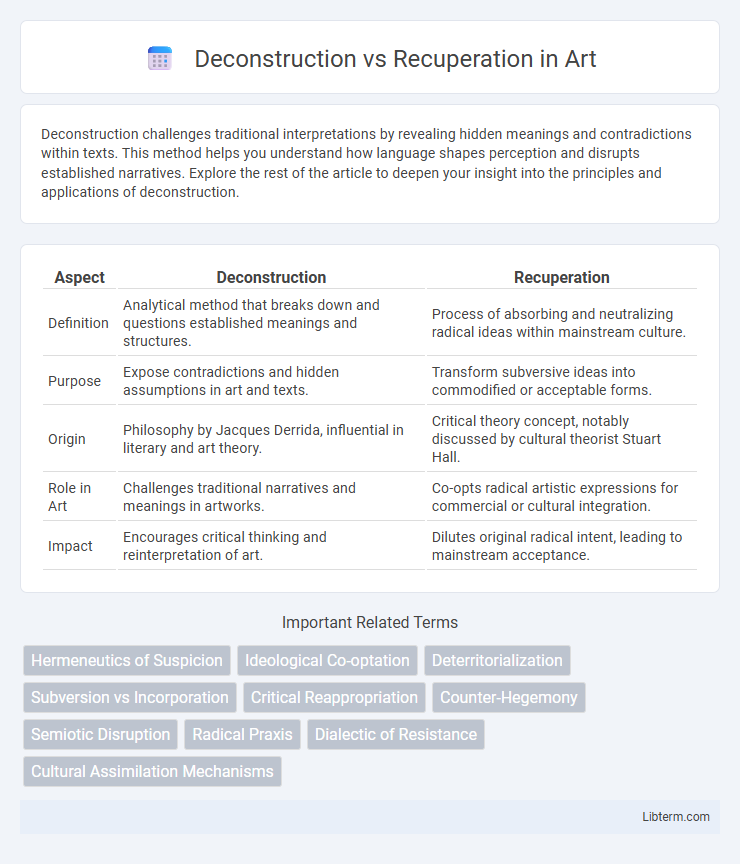Deconstruction challenges traditional interpretations by revealing hidden meanings and contradictions within texts. This method helps you understand how language shapes perception and disrupts established narratives. Explore the rest of the article to deepen your insight into the principles and applications of deconstruction.
Table of Comparison
| Aspect | Deconstruction | Recuperation |
|---|---|---|
| Definition | Analytical method that breaks down and questions established meanings and structures. | Process of absorbing and neutralizing radical ideas within mainstream culture. |
| Purpose | Expose contradictions and hidden assumptions in art and texts. | Transform subversive ideas into commodified or acceptable forms. |
| Origin | Philosophy by Jacques Derrida, influential in literary and art theory. | Critical theory concept, notably discussed by cultural theorist Stuart Hall. |
| Role in Art | Challenges traditional narratives and meanings in artworks. | Co-opts radical artistic expressions for commercial or cultural integration. |
| Impact | Encourages critical thinking and reinterpretation of art. | Dilutes original radical intent, leading to mainstream acceptance. |
Understanding Deconstruction: Key Concepts
Deconstruction, a critical theory developed by Jacques Derrida, challenges traditional structures by exposing inherent contradictions and assumptions within texts and cultural artifacts. It emphasizes the fluidity of meaning and the instability of language, revealing how dominant interpretations suppress alternative readings. This approach destabilizes fixed binaries and hierarchies, encouraging a more nuanced interrogation of power and ideology in literature, philosophy, and social contexts.
Defining Recuperation in Cultural Contexts
Recuperation in cultural contexts refers to the process by which radical or subversive ideas are absorbed and neutralized by mainstream culture, transforming potentially disruptive elements into commodities or harmless expressions. This concept highlights how dominant power structures co-opt oppositional movements, thereby preserving the status quo while appearing to embrace change. Understanding recuperation is crucial for critically analyzing the dynamics between cultural resistance and institutional appropriation.
Historical Origins: Deconstruction vs Recuperation
Deconstruction originated in the late 1960s through the work of philosopher Jacques Derrida, emphasizing the critique and dismantling of traditional metaphysical concepts and texts to reveal inherent contradictions and assumptions. Recuperation, rooted in Marxist theory and later cultural studies, describes the process by which radical or revolutionary ideas and symbols are absorbed, neutralized, and commodified by dominant capitalist systems to maintain status quo. Historically, deconstruction challenges established meanings and structures, whereas recuperation functions as a mechanism to appropriate and dilute oppositional resistance within prevailing power dynamics.
Philosophical Foundations and Influences
Deconstruction, rooted in Derrida's philosophy, challenges traditional structures by exposing inherent contradictions and emphasizing the instability of meaning, while recuperation, influenced by Marxist and Frankfurt School thought, focuses on reabsorbing disruptive elements into dominant ideology for social control. The philosophical foundation of deconstruction lies in post-structuralism and phenomenology, emphasizing differance and the fluidity of interpretation. Recuperation draws from critical theory, highlighting power dynamics and ideological manipulation to neutralize subversive critiques within capitalist frameworks.
Mechanisms of Deconstruction in Theory and Practice
Mechanisms of deconstruction in theory operate by dissecting ideological texts to reveal inherent contradictions and assumptions undermining dominant narratives. In practice, it entails critical analysis and subversion of cultural symbols, exposing power structures embedded in language and media representations. This process destabilizes fixed meanings, enabling alternative interpretations that challenge hegemonic discourse and promote emancipatory potentials.
How Recuperation Functions in Society
Recuperation functions in society by absorbing and neutralizing radical ideas or cultural resistance, transforming them into mainstream norms that reinforce existing power structures. This process co-opts subversive movements, diluting their critical impact while maintaining social and ideological stability. By recontextualizing dissent as acceptable or commodified expression, recuperation prevents substantial societal change and sustains the status quo.
Case Studies: Deconstruction at Work
Deconstruction in architecture emphasizes the systematic dismantling of buildings to maximize material reuse and minimize waste, as seen in projects like the Bullitt Center in Seattle where over 90% of materials were salvaged. Recuperation, however, often involves repurposing discarded materials without significant alteration, exemplified by the Casa de Retalhos in Brazil, which uses recovered construction debris as artistic elements. These case studies highlight deconstruction's role in sustainable urban development by prioritizing material lifecycle extension through strategic disassembly.
Case Studies: Recuperation in Action
Case studies of recuperation in action reveal how countercultural symbols and practices are absorbed and neutralized by dominant systems, turning radical critique into mainstream trends. Examples such as punk fashion evolving into commercial styles or activist slogans being co-opted for advertising campaigns illustrate the process of recuperation effectively diluting oppositional meanings. These case studies demonstrate the continuous cycle where deconstructive efforts are subverted by recuperation, highlighting the challenge of maintaining authentic resistance within cultural production.
Tension and Interplay between Deconstruction and Recuperation
Deconstruction challenges dominant ideologies by dissecting and exposing underlying contradictions, creating a critical space for alternative perspectives, while recuperation absorbs these radical critiques, neutralizing their disruptive potential by recontextualizing them within mainstream frameworks. This tension between deconstruction's destabilizing intent and recuperation's reabsorption process reveals an ongoing interplay where subversive ideas are continuously negotiated between resistance and accommodation. The dynamic interaction shapes cultural, political, and intellectual landscapes, highlighting how transformative possibilities are both activated and constrained through this dialectical relationship.
Implications for Social Change and Critical Thought
Deconstruction challenges dominant ideologies by exposing contradictions and power structures, enabling critical thought to question established norms and inspire emancipatory social change. Recuperation, however, can neutralize radical critiques by absorbing and commodifying dissent within mainstream culture, often diluting transformative potential and reinforcing existing systems. The tension between deconstruction and recuperation highlights the complexity of achieving genuine social change amidst ongoing struggles over meaning and cultural authority.
Deconstruction Infographic

 libterm.com
libterm.com